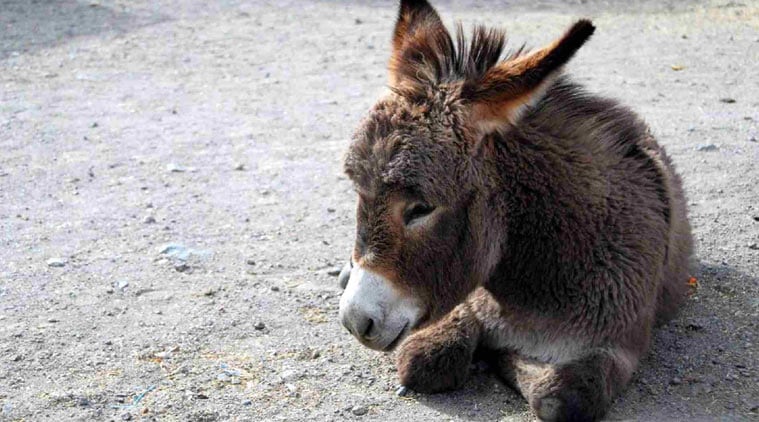- India
- International
Down in Jungleland: Not a Pain, the Ass
You can badmouth them for all you’re worth, but there’s a lot more to donkeys than they let on
 We think donkeys and asses (they’re the same thing) are dumb and stupid and stubborn, because, they often refuse to do what we tell them, or want them to. It turns out that they don’t want to do what we want them to do (like walk off a cliff) because they think it’s stupid and dangerous and not good for them.
We think donkeys and asses (they’re the same thing) are dumb and stupid and stubborn, because, they often refuse to do what we tell them, or want them to. It turns out that they don’t want to do what we want them to do (like walk off a cliff) because they think it’s stupid and dangerous and not good for them.
We all know and deal with dozens of them every day. We meet them everywhere: at home, in schools and colleges, at the workplace, in the government, the bureaucracy, on the roads, at matches, in television studios, at the movies, malls, restaurants, you name it. Yes, we encounter donkeys, asses, mules, jackasses, gadhas, imbeciles, idiots, twits, twerps, fools, jerks et al at every turn and around every corner.
Often, by the time we reach our destination, we’ve encountered so many that we’re champing at the bit to kick some ass. Yet, should we be? I wanted to find out why donkeys and asses have been vilified so, all through our long association with them (and by such luminaries as Aesop and Shakespeare) and found something interesting.
We think donkeys and asses (they’re the same thing) are dumb and stupid and stubborn, because, they often refuse to do what we tell them, or want them to. It turns out that they don’t want to do what we want them to do (like walk off a cliff) because they think it’s stupid and dangerous and not good for them. So they dig in their heels and say no! Just as we would if someone told us to do something we thought was stupid and dangerous and not good for us, right? And for this we call them donkeys! Can’t you just hear them go, “hee-haw, hee-haw”?
They’ve been patient partners with us for the last 5,000 years or so. Their ancestors were the wild asses of Africa, tough, hardy souls that lived in arid semi-desert countries, who developed their loud hilarious bray and enormous furry ears (‘like errant wings’) the better to communicate with over long distances.
Two cousins of the African wild ass are found in our region: the Indian wild ass found in Kutch, which nearly became extinct in the 1960s; and the Kiang or Tibetan wild ass —and the largest of their clan — that forages in the high Himalayas (in Ladakh, the Tibetan plateau and northern Nepal).

Amongst the domesticated variety, gentlemen donkeys are called jacks, the ladies are known as jennys. They are, of course, related to horses, and we had to meddle with their love lives and cross them. Jacks mating with mares produce mules, and jennys mating with stallions produce hinnies. Both are usually sterile, and mules are more common.
Horses, of course, are the glam guys and gals of the Equus clan; tall, dark (or not) and handsome, pawing the ground and rolling their eyes. They’re also neurotic, high-strung, and prone to throwing you off and fleeing when a paper bag flutters across the road. Donkeys are calm, phlegmatic, no-nonsense souls: they just plod on regardless if you are in a delicious “donkey doze” on their backs and will probably eat the paper bag if it snagged on a bush. No hysterics, no tantrums, just eternal patience and forbearance: little yogic horses if you like. Donkeys have often been made stable companions to pernickety race or show horses, especially as babysitters to their foals at weaning time.
They calm them down (with melancholic sighs, lullabies and gentle nuzzling, one imagines). They’re even used to guard sheep and goats and will let loose with that brassy bray if a predator appears, even kicking the predator’s ass if necessary. That’s why they don’t get along too well with dogs.
When we first started domesticating them, around 3000 BC, they were considered (I still can’t quite believe this) to be status symbols like the ownership of a Rolls-Royce would be. It’s been mostly downhill for donkeys ever since: they’re now associated chiefly with the developing world where they’re used as pack animals. Of the world’s 40 million plus donkeys, 11 million live in China, and Pakistan has the next highest number (no double entendre intended!). In India, you often see them at road-works or major building projects, patiently hauling rubble and rocks, nodding gently to themselves, sad-eyed as ever, waiting for their day in the sun. One handsome big guy, Sheru, recently made news, being valued at Rs. 3 lakh, or as the news report mentioned, “the price of two Nanos” (what a climbdown from the Rolls-Royce days). In the West, they have an easier life, giving rides to children and being kept as pets (they are good with brats).
England has the biggest donkey sanctuary in the world for discarded and retired animals. Donkeys are hardy, low-maintenance animals, happy with hay and yet produce milk which is higher in sugar and lower in fat than cow’s milk (and was once considered medicinal.) Two of the world’s most celebrated donkeys are, of course, the eternally melancholic Eeyore in Winnie the Pooh, contrasted marvellously with the equally eternally ebullient Donkey in Shrek!
So the next time you exasperatedly yell “Oye gaddhe” at someone, be aware that you may be paying him a compliment, and that he will probably not think so and may proceed to kick your teeth in. Just as an angry jack would.
Ranjit Lal is an author, environmentalist and birdwatcher
Must Read
May 21: Latest News
- 01
- 02
- 03
- 04
- 05

































